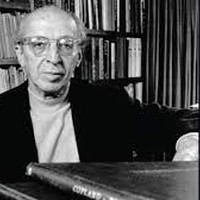Copland’s Appalachian Spring
Sponsored By
- November 30, 2019

Sponsored By


After studying in Paris with Nadia Boulanger, Aaron Copland returned to America in 1924 with a taste for the spiky, crystalline sounds of modern European music, a style popularized by Stravinsky and the young French composers known as “Les Six.” Copland had some success with the early works that he studded with jazz elements, but as he ventured deeper into the austere and elemental sound of neoclassicism, performers and audiences alike chafed at his bold new approach. One score that suffered a particularly cold reception was the Short Symphony from 1932–33, later renamed the Symphony No. 2. Copland himself saw hope for this music in a more practical configuration, and he arranged it in 1937 as a Sextet, scored for clarinet, string quartet and piano. The version heard here, arranged by the conductor Dennis Russell Davies in 1978 (during his tenure as music director of The Saint Paul Chamber Orchestra), uses a chamber orchestra to maintain the symphonic scope of Copland’s original while navigating the irregular rhythms and darting phrases with more nimble forces.
Aaron Grad ©2019
Whether composing for the concert hall, the opera house or the Hollywood sound stage, John Corigliano has made his mark producing scores of uncanny beauty and sensitivity. It is a testament to his enormous range that he won an Academy Award for film scoring in 2000 for his work on The Red Violin, followed by a Pulitzer Prize the next year for his Symphony No. 2. The version of Voyage heard here, arranged for flutist James Galway and strings in 1983, started as a work for a cappella chorus, based on the translation by Richard Wilbur of L’Invitation au voyage” by the French poet Charles Baudelaire. As Corigliano wrote in a program note, “Wilbur’s poignant setting pictures a world of obsessive imagination — a drugged version of heaven full of sensual imagery. The music echoes the quality of the repeated refrain found in this lush translation: ‘There, there is nothing else but grace and measure, richness, quietness and pleasure.’”
Aaron Grad ©2019

By the time Copland introduced his Symphony No. 3 in 1946, which included the rousing Fanfare for the Common Man, he was the clear leader among American composers. His music even caught the ear of an unlikely champion of contemporary concert music: Benny Goodman, the “King of Swing,” who had taken to using the windfall from his commercial successes to commission new repertoire for the clarinet. Goodman gave Copland $2,000 and free reign on what to compose. Two years later, Copland delivered his Clarinet Concerto, scored for a small orchestra of strings, harp and piano. The structure is more compact than a typical concerto, using only two linked sections instead of three separate movements. A cadenza connects the two sections, with the clarinet playing music that gives an impression of free improvisation, even though it is fully notated.
Aaron Grad ©2019

I remember my first piano lesson when I was five years old. My teacher brought out a strip of very thin cardboard and placed it behind the keys. Each color on this strip represented a specific note of the C major scale. The color of each note head on my beginner’s sheet music corresponded with the colors on the cardboard strip. To this day, I associate keys with these colors. In 2015, I composed a series of preludes for piano and string quartet inspired by the glorious set of preludes for piano solo by Frederic Chopin. Continuing to associate pitch with color, I toyed with the idea of sharing my color preferences for my set of preludes. However, as one’s experience of life is unique, so is one’s experience of tonality. Just because I experience G as green doesn’t mean someone else should. This realization led to a decision to instead give each of these preludes a character title instead, allowing listeners to experience the rainbow of chromaticism in their own peculiar way. A simple question awaits: What color do you hear?
Aaron Grad ©2019
 Listen to Audio
Listen to Audio
In the wake of two well-received ballets set in the American West — Billy the Kid (1938) and Rodeo (1942) — Aaron Copland began Appalachian Spring in 1943. He created the ballet for the dancer and choreographer Martha Graham, and he worked under the title Ballet for Martha until not long before the premiere, when Graham suggested Appalachian Spring, borrowing a phrase from Hart Crane’s poem “The Bridge.”
Created for the 500-seat auditorium at the Library of Congress in Washington, DC, this ballet needed a suitably compact pit orchestra, so Copland used just thirteen instruments in the original version. The next year he arranged most of the ballet into a concert suite for orchestra, and his publisher later added the option heard here, which preserves the original chamber ensemble scoring while adopting the structure of the concert suite.
The wonder of Appalachian Spring is how it achieves so much using such simple and familiar musical ingredients. The first section assembles its hazy wash of consonant sonorities by enunciating plain triads and the resonant intervals of fourths and fifths. The following section energizes similarly basic materials — octave leaps, triadic intervals and descending major scales — into spry dance music. There is a tender scene for the young couple, a lively romp depicting the revivalist and his dancing minions, and then a brisk solo dance for the bride, which dissipates into a return of the gentle, triadic wash of the beginning.
The famous section that follows, starting with a theme in the clarinet, presents the tune of Simple Gifts, a Shaker dance song written in 1848 by Joseph Brackett. The humble melody fits seamlessly into the homespun, diatonic language of Copland’s score, and its increasingly grand variations rise to a transcendental climax.
Aaron Grad ©2021
Can't attend any of these performances? Join us for an open rehearsal on Thursday, November 27 at 10:00am
Get driving directions and find nearby parking.
Find dining options close to the venue.
View seating charts to find out where you'll be seating.
SPCO concerts are made possible by audience contributions.
For exclusive discounts, behind-the-scenes info, and more:
Sign up for our email club!
